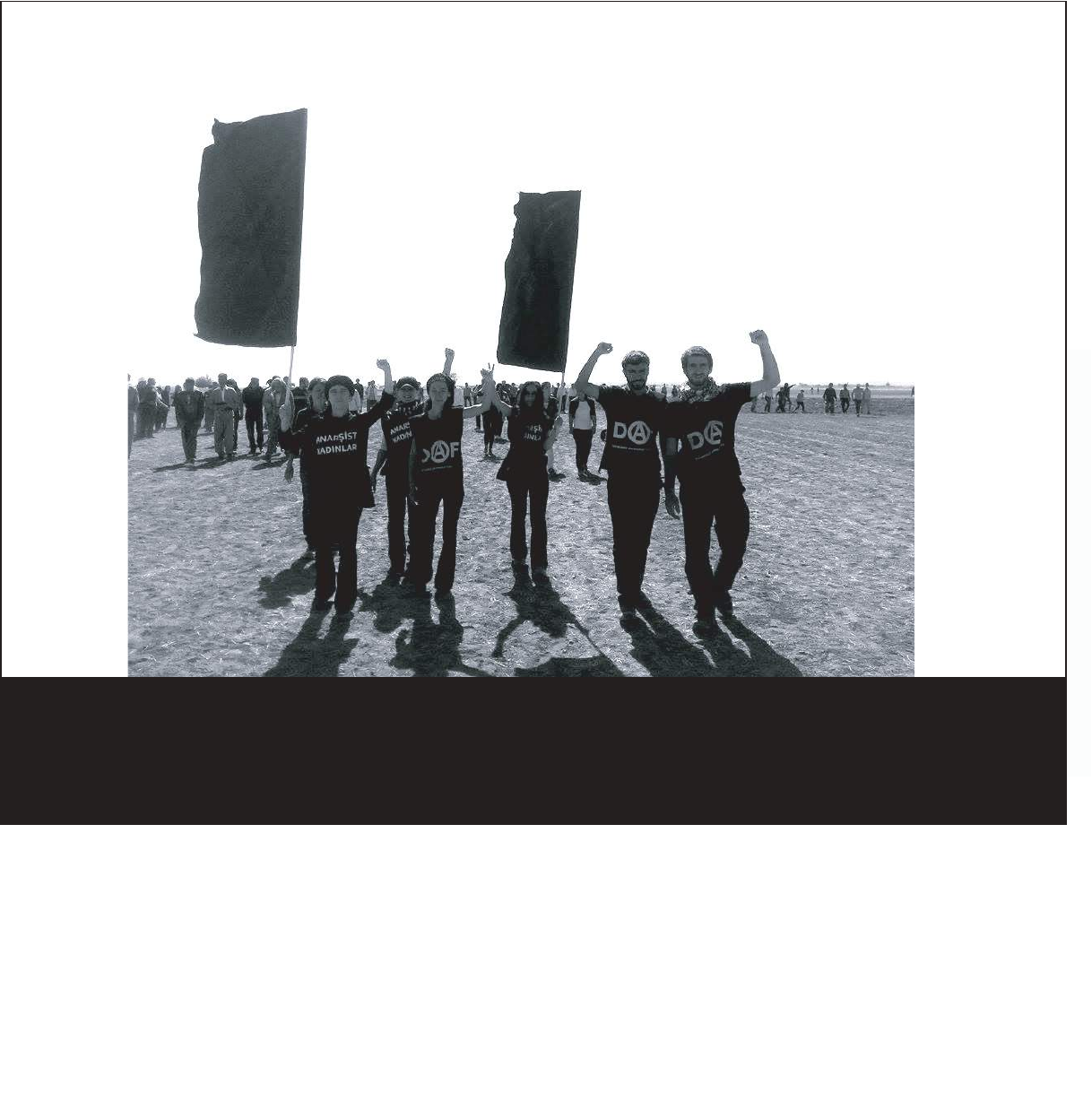
ANARCHISM IN
THE MIDDLE EAST
The Rojava Revolution
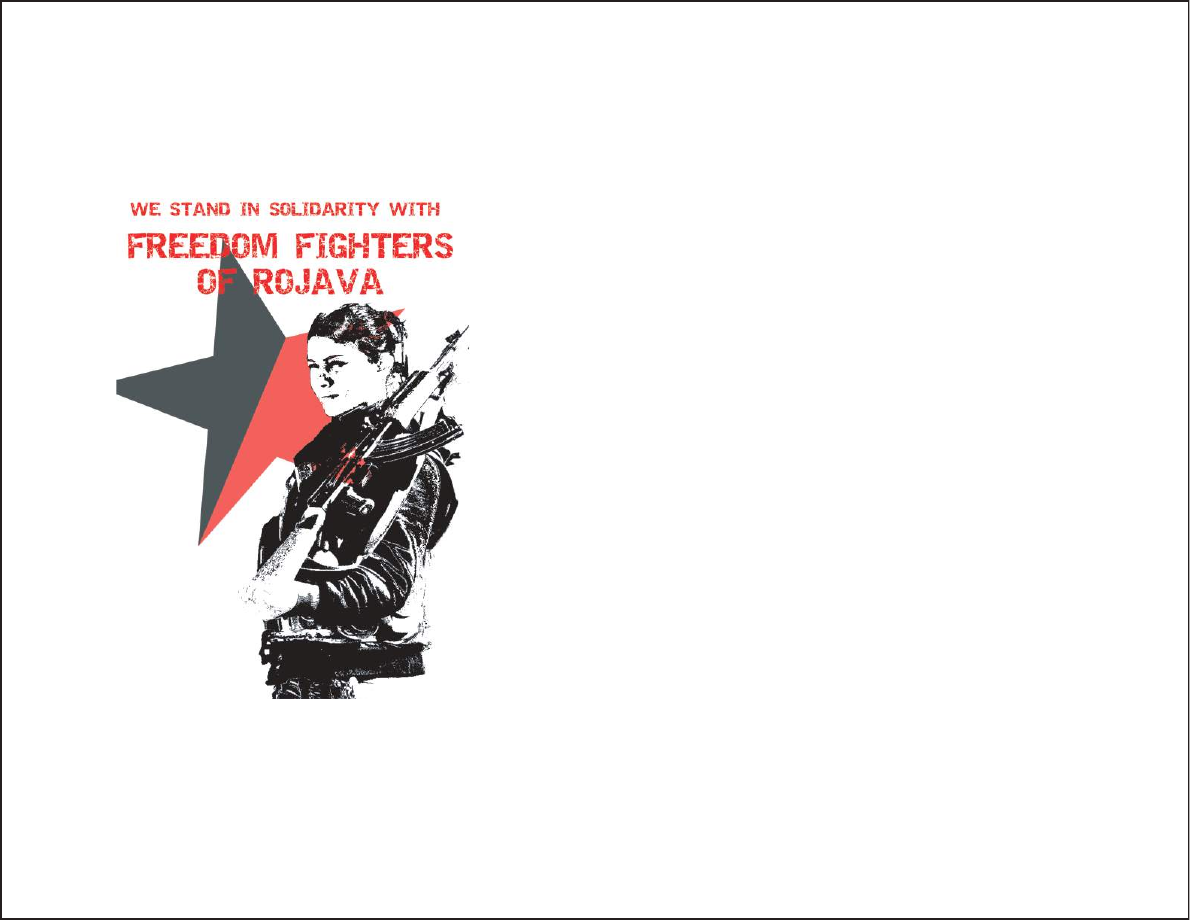
The people of Rojava are engaged in one of the most liberatory social projects of
our time. What began as an experiment in the wake of Assad’s state forces has
become a stateless aggregation of autonomous councils and collectives. What
began as a struggle for national liberation has resulted in strong militias and
defense forces, the members of which fully participate in the unique social and
political life of their region. What started as a fight for Kurdish people has resulted
in a regional home for a Kurds, Arabs, Syrians, Arameans, Turks, Armenians,
Yazidis, Chechens and other groups. What began as the hierarchical Marxist-
Leninist political party, the PKK, has evolved into what its leader Abdullah Öcalan
calls "Democratic Confederalism", a “system of a people without a State”, inspired
by the work of Murray Bookchin.
What we see in Rojava today is anarchism in practice.
Each Canton subscribes to a constitution that affirms a society free from authori-
tarianism and centralism, while allowing for pragmatic autonomy and pluralism.
Councils are formed at the street, city, and regional levels. While each council
functions differently in cohesion with local particularities, a few key similarlities can
be found throughout. Committees are self-organized, the councils mediate conflict
on an individualized level, cooperatives strive for economic independence through
local production.
The explicit intention of the Cantons is to remain decentralized and stateless, and
to extend this practice beyond state borders where nascent councils have already
usurped the state in dealing with day-to-day affairs.
We, in Rojava Solidarity NYC, express unwavering solidarity with the people of
Rojava, the anarchist nature of this project, and with the revolutionary intentions
behind it.
Now the people of Rojava and the extrordinary social project they have established
finds themselves under the threat of violent extermination and repression. The
reactionary forces of the Islamic State of the Levant are attacking on multiple
fronts, engaging the People’s Protection Units, regional militias, local people, and
anarchist support units in the fight for their lives and the free territory they have
built. Turkey’s Erdogan, afraid of the Kurdish independence project, is squeezing
the region from the North, blocking support and supplies.
Rojava Solidarity NYC has been formed to support the Cantons of Rojava in this
dire time of need, to publicize this incredible social structure and the struggle it is
engaged in, and to provide a forum where we can learn from the pragmatic
anarchism in this region. We call on those in the radical left and beyond to do the
same and to support the autonomous territory of Rojava.
Rojava Solidarity NYC
Solidarity With the Rojava Revolution

bases, weapons, resources, and a place for exiles from other communist regimes,
including Cuba, Angola, Vietnam and others, but not a one of those countries was
interested in supporting their communist cousins in such a complicated geopolitical
area without backing from the USSR. Some socialist countries did bring up UN
resolutions, and most of the Soviet sphere voted for measures in support of
Kurdish autonomy in Kurdistan. Russia, along with UN Security Council member
China, has also refused to designate the PKK or any other Kurdish political groups
as terrorist organizations.
Western governments and organizations such as NATO have been involved in one
side or another of the Kurdish questions since the ear¬ly 19th century at the dawn
of the Kurdish autonomy movement. The French and the British foreign offices
have used various regional Kurds and their dreams of autonomy as proxies to
secure their mandates in the Middle East and to thwart each other. During
particular crises, for example immediately following World War I and World War II,
shadowy diplomats were shuttling between Paris or London to Kurdish shepherd
villages, bringing a little aid and vague promises of support if the Kurds supported
their particular political machinations. European powers did not limit their role to
just the territory of Kurdistan either, and also used their home countries to get
involved in the Kurdish Question. Countries like Germany, Belgium, and the
Netherlands for a while allowed mili¬tant Kurdish training bases to operate on
their soil but would raid and shut them down depending on the geopolitical winds
of the time. Greece supplied Kurds in Turkey and housed exiled PKK officials in
order to punish Turkey for their 1974 invasion of Cyprus, but after coming to
agreement on trade with Turkey they kicked the PKK out and stopped all aid.
France even tried to use Kurds to slow Algerian independence, despite the fact that
there were no Kurds in Algeria, by implying they may give them territory in a
French-owned Algeria.
The US was late to the show of manipulating the Kurds’ desire for
freedom. During the Cold War the US mostly found itself siding with the Shah of
Iran and using CIA personnel and resources to help both repress the Kurds in Iran
and foment Kurdish rebellions in Iraq. The US stuck to covert operations, and thus
little was known until recently about US involvement in the Kurdish Question.
During the first Gulf War, when Iraq occupied the oil-rich emirate of Kuwait in
August 1990, Saddam Hussein became America’s enemy number one. Yet from
1987 until the Iraqi invasion of Kuwait, the US said nothing. At times, the US even
supported Iraq in the UN, when Saddam Hussein was gassing tens of thousands
of Kurds and bombing whole Kurdish towns and villages. But at the beginning of
the First Gulf War, George Bush Sr. publicly de¬clared Kurds are the US’s
“natural allies” and suggested they should revolt against the Baghdad regime. Of
course, Bush Sr. knew that the Kurds had already been fighting the Ba’athist regime
in a bloody, fifteen-year, on-again off-again civil war.
After the war, the US put in place an ineffective no fly zone, which
ap¬parently did not include helicopters, to “protect the Kurds.” Thousands of
Kurds and other civilians in northern Iraq were killed by Saddam’s military while
US planes flew overhead doing nothing. During the sec¬ond Gulf War, the US
The Kurdish Question has never been a strictly regional affair. Since
before World War I until today, powers stretched over the entire globe—from
Australia to America—have been involved in this issue. From Iraq to Egypt, the
Kurds have been used as pawns to leverage the players of the region. Just like in a
game of chess, the Kurdish pawn is often sacrificed to gain a better position on the
board. Over and over again, foreign pow¬ers intervene for a brief period of time,
encouraging Kurdish rebellion just to withdraw support at crucial points and
sacrificing the Kurds when they are no longer needed. Sometimes world powers
support one Kurd¬ish rebellion while simultaneously backing another regime’s
crackdown on Kurdish villages only a few hundred miles away across the border.
Kurdish autonomy has been used as a functional and disposable tool for achieving
other countries’ agendas from the realignment of the region af¬ter WWI, the rise
of Soviet power, through the Cold War and the spread of Nasserism, to George
Bush Sr.’s New World Order. Kurdish autono¬my has always been a means to end,
never an end to itself, for the many states that have gotten involved over the years.
Owing to their precarious position, the Kurds have been led to naively believe,
decade after decade, that the world powers actually cared about their cause while
they were being manipulated for someone else’s momentary geopolitical advan-
tage.
The Soviet Union’s relationship to both its own 450,000 Kurds and the
Kurds in Kurdistan was also marked mostly by state suspicion and repression. In
the first years of the Soviet Union, Kurds, like many other minority groups, were
forcibly displaced and a special regional govern¬ment unit was set up to monitor
them. This regional unit was reorganized several times and ultimately disbanded in
1930 when the Stalinist central government feared it had become too sympathetic
to the Kurds. Un¬der Stalin, tens of thousands of Kurds were deported from
Azerbaijan and Armenia to Kazakhstan, while Kurds in Georgia became victims of
the purges that followed the end of WWII. Through the 1960s, various measures
were taken by the Soviet Regime to marginalize and oppress its Kurdish popula-
tion. In the 1980s the PKK, the only Kurdish politi¬cal party to partner with
Kurds in the USSR, began collaboration with Kurds living in the Transcaucasia
region and made serious inroads with the population there. By 1986, non-armed
PKK support organizations had formed in the USSR, though they were technically
illegal. According to Turkish press, there was even a PKK organization in Kazakh-
stan in 2004.
For the most part the Soviet Union, and later the Russian Federa¬tion,
has not been involved directly with Kurdish Independence since the 1940s, when it
supported an autonomous Kurdish state in Iran. Despite the PKK’s early commu-
nist roots, the Soviet Union never sup¬ported it because of the USSR’s ties with
Syria and Turkey. Today the Russian Federation is reluctant to actively support
Kurdish independence in Kurdistan because of its own restive minorities, including
the Russian Kurds. At various times the PKK has sought support for training
Power and The Kurds
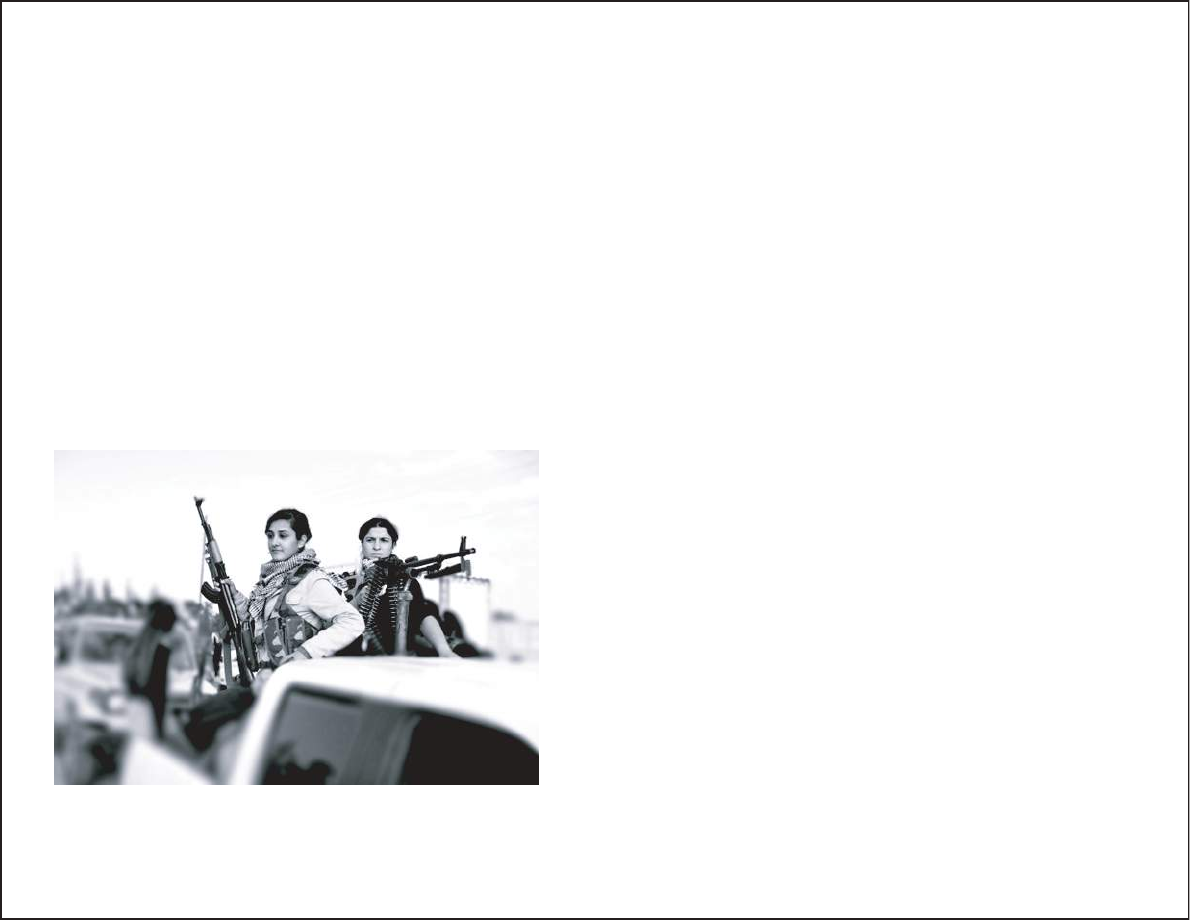
While the PKK was not founded by die-hard communists, it soon
be¬came a classic Maoist national liberation struggle party complete with an
unquestioned charismatic “father of the people”, Abdullah Öcalan, a.k.a Apo.
There was little to differentiate the PKK from the dozens of Mao-in¬spired
militant liberation groups of the late 1970s and 1980s.
The PKK weren’t the only committed Marxists in Kurdistan— a number
of other smaller groups existed, some claiming to be Leninists, Trotskyites, or even
Titoists. But the peasant-based insurrectionary phi¬losophy of Maoism, as
espoused by the polit-bureau and the leadership of the PKK, was by far the most
popular and militarily effective means of resisting oppression.
The PKK’s flamboyant embrace of communism garnered some sup¬port
from the calcified old Left parties of Western Europe, but it failed to produce
much in the way of real solidarity. While certain Maoist ideas appealed to Kurds
eager to rid themselves of authoritarian state repression, those same ideas alienated
a lot of potential, more liberal, supporters. Thus, the PKK’s struggles were largely
ignored and some¬times condemned by possible sympathizers in and outside the
region. The emphasis on centralization in Maoist communism also alienated many
of the social leaders inside Kurdistan. The Kurds traditionally have been socially
and politically organized by loosely connected tribes and have supported tribal
leaders who had distinguished themselves in some way other than heredity.
Periodically, Kurds formed large, temporary confederations of tribes to mount
uprisings and military actions. Politi¬cal parties have never gained the monopoly
on political organizing that they have in many other parts of the world—it wasn’t
uncommon for a Kurd to be part of a few political parties and switch between
them based on how successful they were. Despite these cultural obstacles, the PKK
championed hardline communism until well after the fall of the Soviet regime.
For the PKK, the crisis in their communist faith didn’t occur until 1999
when their leader Öcalan was arrested in Nairobi by the MIT (Turkish military
intelligence), flown back to Turkey, and incarcerat¬ed on a prison island upon
which he was the only inmate. The Turkish media showed a humiliated Öcalan,
“the Terrorist of Turkey,” harmless and in chains. With their leader captured and
no obvious successor, the PKK’s central committee was thrown into crisis. The
increasingly mili¬tant tactics of bombings, roadside ambushes, and suicide
bombers were not working, and the rise of Jihadi attacks in the Middle East and
the West made the PKK seem just like another Islamic terrorist organiza¬tion
despite its communist ideology. This, combined with the collapse of communism
in Eastern Europe and Russia, led to a period of ideological soul-searching for the
PKK and its leader.
Thousands of miles away, on January 1, 1994 (five years before Öcalan’s
capture) a new type of liberation struggle kicked off in the for¬gotten mountain
jungles of Chiapas, Mexico. The Zapatistas, with their red star flag and their black
masks, burst onto the world stage and quickly inspired the progressive Left around
asked again for the peshmerga (the military forces of Iraqi Kurdistan) to help rid
the country of the Ba’athist regime. This time, the Kurds decided to focus on
securing the north for themselves and on creating an army that could defend
itself—they’d learned their les¬son from the first Gulf War. Today the Kurdistan
Regional Government (KRG) exists not because the US protected the Kurds, but
because they took US and coalition aid and resources to prepare their own defense.
The KRG also pursued its own diplomatic strategy with the fledgling and factious
National Iraqi Congress.
Many other countries, from China to Australia, have interfered in the
Kurdish Question, ultimately thwarting the Kurdish dream of freedom across a
unified Kurdistan. Today almost all countries in the West have designated Kurdish
militant groups as terrorists while at the same time trying to enlist their help in the
war against the Islamic State and other Jihadist groups. It seems the Kurds have
lost some of their naivete and have learned that being temporary sacrificial pawns
for the West will not aid their cause in the long run. The lesson of the second Gulf
War and the recent Syrian civil war is that the Kurds must rely on their own forces
to have any hope of securing autonomy and justice for their people.
From Red Star to Ishtar’s Star

the spring had morphed into a full-on armed insurrection against the Assad regime.
When the protests first began, Assad’s government finally granted
citizenship to an estimated 200,000 stateless Kurds in an effort to neutralize
potential Kurdish opposition. By the beginning of 2012, when over 50% of the
country was controlled by rebel groups and Islamic militias, and Assad’s forces
were spread thin, the regime decided to pull all military and government officials
out of the Kurdish regions in the north, in effect handing the region over to the
Kurds and Yezedis living there. Oppo¬sition groups, most prominently the
PKK-aligned Democratic Union Party (PYD), created a number of coalition
superstructures to administer the region. There was tension between PYD and
parties aligned with the Kurdish Regional Government (KRG) in Iraq, however,
and at one time there were even two competing coalitions: the PYD-backed
Na¬tional Coordination Committee for Democratic Change (NCC) and the
KRG-aligned Kurdish National Council (KNC). In early 2012, when it looked like
the tension between the two groups might result in armed conflict, the President
of the KRG Massoud Barzani and leaders of the PKK brought the two groups
together to form a new coalition called the Supreme Kurdish Council (SKC) made
up of over fifteen political parties and hundreds of community councils. Within
months of form¬ing, the SKC changed its name to the Democratic Society
Movement (TEV-DEM) and added non-Kurdish groups, political parties, and
orga¬nizations to the coalition. The TEV-DEM created an interim governing body
for the Rojava region.
the world. A small Mayan liberation struggle had risen from the Lacandon Jungle
of Southern Mexico and declared themselves autonomous. These politically savvy
revolutionaries created a new type of leftist insurrectionary political configuration
they called Zapatismo. Zapatismo situated itself as a mode of liberation and leftist
struggle that rejected hierarchy, party control, and aspirations to create a State
apparatus. The architects of this new configuration had spent years in hardline
Marxist guerrilla organizations in Mexico before rejecting that model of struggle
and seeking a new approach.
Öcalan and the other leaders in the central committee of the PKK were
familiar with the rapid rise and success of the Zapatistas. A year before his arrest,
Öcalan had spoken to PKK party leaders about Zapatismo at a two-day confer-
ence. And in his first months of imprisonment, Apo had a “crisis of faith”
regarding doctrinaire Marxist ideology and its ability to free the Kurds. Öcalan,
who spent much of his life espousing a hardline Stalinist doctrine, started to reject
Marxism-Leninism in favor of direct democracy. He had concluded that Marxism
was authoritari¬an, dogmatic, and unable to creatively reflect the real problems
facing the Kurdish resistance. In prison, Apo started reading anarchist and
post-Marxist works including Emma Goldman, Foucault, Wallerstein, Braudel, and
Murray Bookchin. Öcalan was particularly impressed with Bookchin’s anarchist
philosophy of ecological municipalism, going so far as to demand that all PKK
leaders read Bookchin. From inside prison, Öcalan absorbed Bookchin’s ideas
(most notably Bookchin’s Civilization Narratives) and wrote his own book based
on these ideas, The Roots of Civilization (2001). It was Bookchin’s Ecology of
Freedom (1985), however, which Öcalan made required reading for all PKK
militants. It went on to influence the ideas found in Rojava.
In 2004, Öcalan tried to arrange a meeting with Bookchin through his
lawyers, describing himself as Bookchin’s “student” and eager to adapt Bookchin’s
ideas to the Kurdish question. In particular, Öcalan wanted to discuss his newest
manuscript, In Defense of People (2004), which he had hoped would change the
discourse of the Kurdish struggle. Unfortunately for Öcalan, the 83-year-old
Bookchin was too ill to accept the request and sent back a message of support
instead. Murray Bookchin died of congested heart failure two years later, in 2006.
A PKK congress held later that year hailed the American thinker as “one of the
greatest social scientists of the 20th century,” and vowed that “Bookchin’s thesis
on the state, power, and hierarchy will be implemented and realized through our
struggle.... We will put this promise into practice, this as the first society that
establishes a tangible democratic confederalism.” Five years later, in 2011, the
Syrian civil war gave the Kurds a chance to try to make good on their promise.
The Syrian civil war began as part of the general uprisings in spring 2011
in North Africa and the Middle East that the West dubbed the “Arab Spring.”
Kurds from a variety of political backgrounds joined students, Islamists, workers,
political dissents, and others in calling for the end of the repression of the Assad
dictatorship. Syrian President Bashar al-Assad, however, had learned the lessons of
Tunisia, Libya, and Egypt and quickly sent in troops to crush the growing demo-
cratic movement. By autumn, the mostly peaceful protests that had taken place in

making). It is unclear how membership is determined in these councils, but we
know that the opposition movement coun¬cils prior to 2012 had no fixed mem-
bership and anyone showing up at assembly could fully participate. It is also
unclear how often these councils meet and who determines when they meet. It is
known that the neighborhood assemblies in the Efrin Canton meet weekly, as does
one of the hospital workers’ councils. These local councils make up the indivisible
unit of Rojava democracy. Larger bodies (e.g. Supreme Council of the Rojava
cantons) are populated with representatives from these local councils. All decisions
from these “upper councils” must be formally adopted by the local councils to be
binding for their con¬stituents. This is very different from the federalist tradition,
in which the federation supersedes local control. In August 2014, for example, a
regional council decided that local security forces could carry weapons while
patrolling a city, but three local assemblies did not approve this decision, so in
those local assembly areas security must refrain from carrying weapons. The role
of the “upper councils” is currently limited to coordination between the myriad of
local councils while all power is still held locally. Representatives to the “upper
councils” rotate fre¬quently, with a maximum term set by the “upper council,” but
local councils often create their own guidelines for more frequent rotation of their
representatives. The goal of the Rojava council system is to maxi¬mize local power
and to decentralize while achieving a certain necessary degree of regional coordina-
tion and information-sharing.
The remaining government above the upper council level seems sim¬ilar
to a council parliamentary system with rotating representatives, an executive branch
composed of canton co-presidents, and an independent judiciary. All governmental
power emanates from the councils, and the councils retain local autonomy, thus
forming a confederation. The con¬federation is made up of three autonomous
cantons that have their own ministries and militias. There is no federal government
in the Rojava can¬ton system. Voluntary association and mutual aid are key
concepts for the confederation, as these ideas protect local autonomy. Voluntary
associa¬tion leads to radical decentralization, severely limiting any organizational
structures above the primary decision-makers of the local councils. All bodies
beyond the local councils must have proportional representation of the ethnic
communities in the canton and at least 40% gender balance (this includes all
ministries). Most ministries have co-ministers with one male and one female
minister, with the exception of the Women’s Min¬ister. Most decisions by the
Supreme Council need support of 2/3 of the delegates from the upper councils.
Any canton retains autonomy from Supreme Council decisions and may override
them in their own People’s Assembly (the largest upper council of any region)
while still being part of the confederation. This bottom-up decentralization seeks
to preserve the maximum level of autonomy for local people while encouraging
max¬imum political participation.
Both internal and external security for the cantons is administered by each
canton’s People’s Assembly. The local security, which are equivalent to police, are
called Asayish (security in Kurdish). The Asayish are elect¬ed by local councils and
serve a specific term determined by the local council and the canton’s People’s
The TEV-DEM’s program was heavily influenced by the PYD’s ideas of “demo-
cratic confederalism,” which the PKK had adopted as their of¬ficial platform in a
people’s congress on May 17th, 2005. According to the platform, and subsequent
documents and proclamations from Ro¬java, “democratic confederalism of
Rojava is not a State system, it is the democratic system of a people without a
State... It takes its power from the people and adopts to reach self-sufficiency in
every field, including economy.” In Rojava, Democratic Confederalist ideology has
three main planks: libertarian municipalism, radical pluralism, and social ecology.
The TEV-DEM have been implementing this new social vision on a massive scale
in Rojava since early 2012. The PKK has attempted (and succeeded to some
degree) to implement democratic confederalism in scattered villages in Turkey
along the Iraq border since 2009, experiments that served as an inspiration for
much of the Rojava revolution. This vision, in both Turkey and in Rojava, draws
heavily from contemporary anarchist, feminist, and ecological thought.
How do you base a government on anarchism? Rojava is not the first, and
hopefully won’t be the last, experiment in creating a new form of a decen¬tralized
non-state government without hierarchy. In the past two years, two-and-half
million people in Rojava have been participating in this new form of governance, a
governance related to that of the Spanish Rev¬olution (1936), the Zapatistas
(1994), the Argentinian Neighborhood Assembly Movement (2001-2003), and
Murray Bookchin’s libertarian municipalism. Despite some similarities to these past
experiments and ideas, what is being implemented in war-torn Rojava is unique-
and it’s extremely ambitious. It’s no hyperbole to say that this revolution in
northern Syria is historic, especially for anarchists.
At the core of this social experiment are the variety of “local coun¬cils”
that encourage maximum participation by the people of Rojava. The Kurdish
people have a long history of local assemblies based on tribal and familial
allegiances. These semi-formal assemblies have been an important practice of
social organizing for Kurds for hundreds of years, so it is no surprise that the
face-to-face assemblies soon became the backbone of their new government. In
Rojava, neighborhood assemblies make up the largest number of councils. Every
person (in¬cluding teenagers) can participate in an assembly near where they live.
In addition to these neighborhood assemblies, there are councils based on work-
places, civic organizations, religious organizations, political parties, and other
affinity-based councils (e.g. Youth). People often are part of a number of local
councils depending on their life circumstanc¬es. These councils can be as small as
a couple dozen people or they can have hundreds of participants. But regardless of
size, they operate similarly. The councils work on a direct democracy model,
meaning that anyone at the council may speak, suggest topics to be decided upon,
and vote on proposals (though many councils use consensus for their decision-
Democracy and Decentralization
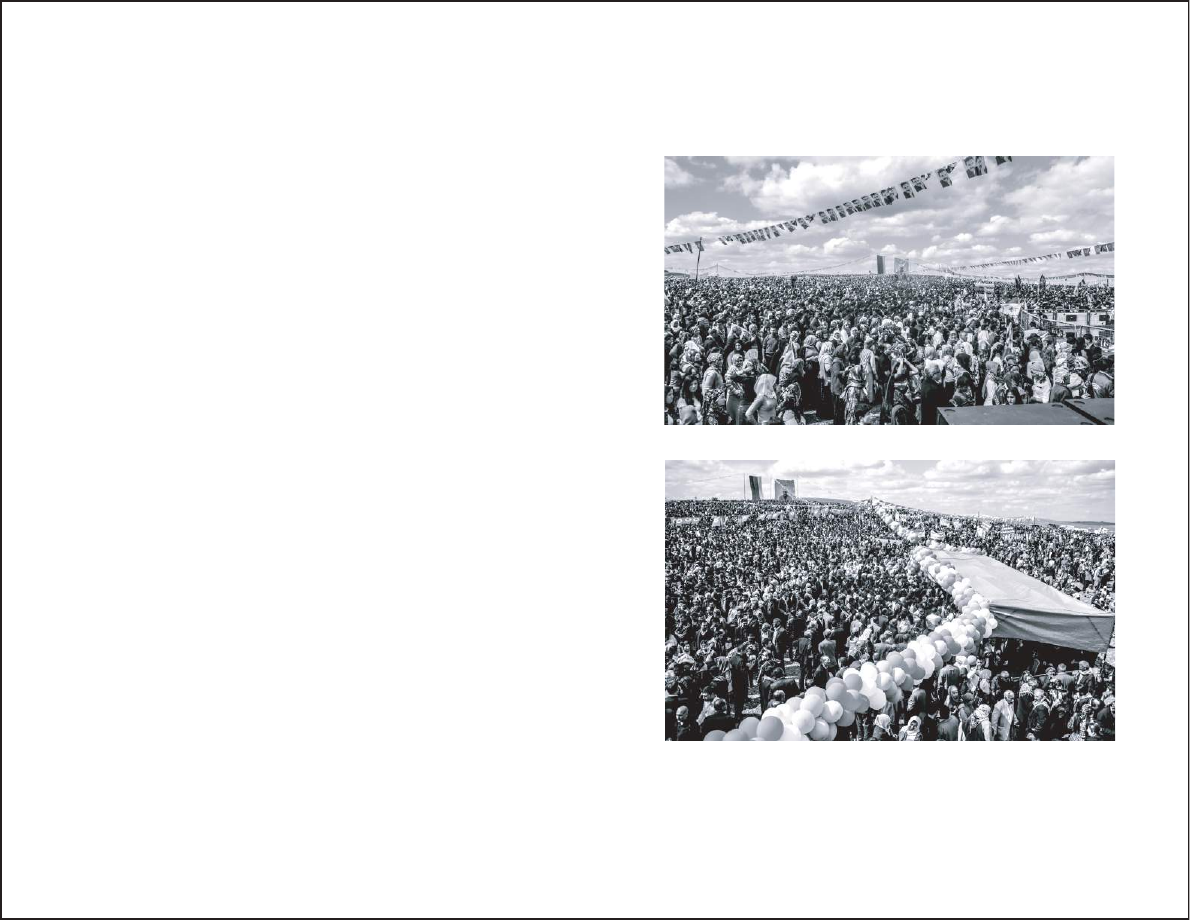
Assembly. The Asayish have also their own assembly (but not one that can send
representatives to the People’s Assembly), in which they elect officers and make
other decisions. In ad¬dition to the Asayish, there are people’s self-defense militias
to provide security from outside threats (e.g. currently the Islamic State, but this
could also include regional and state government forces). These militias elect their
own officers but are directly responsible to the canton’s People’s Assembly. Both
the Asayish and the people’s self-defense militias have two organizations: one a
female-only group and the other co-ed. Militias that are providing mutual aid in
another canton (Asayish are for the most part forbidden to work in other cantons)
must follow that canton’s Peo¬ple’s Assembly but can retain their own command-
ers and units. In times of peace, the cantons do not maintain standing militia
service.
Rojava’s relationship with the Syrian state is yet to be tested. The Ro¬java
Canton Confederation is not set up as a state. It draws instead on the idea of dual
power, an idea first outlined by the French anarchist Proudhon. The KCC
described dual power as “a strategy of achieving a libertarian socialist economy and
political and social autonomy by means of incrementally establishing and then
networking institutions of direct participatory democracy” to contest the existing
authority of state-capi¬talism. Rojava currently has set out a path of co-existence
with whatever state arises from the Syrian civil war and to the current alignment of
neighboring states (namely Turkey, Iraq, and Iran) that encompass Kurd¬istan.
People in Rojava would maintain their Syrian citizenship and participate in the
Syrian state so long as it doesn’t directly contradict the Rojava principles. This
uneasy co-existence is the reason the cantons have explicitly forbidden national
flags, have not created a new currency, a foreign ministry, or national passports and
identity papers, and why they do not have a standing army. It is unclear if the
people of Rojava plan to maintain this relationship with the state or what would
happen in conflictual situations.
Rojava is neither a state nor a pure anarchist society. It is an ambitious
social experiment that has rejected the seduction of state power and na¬tionalism
and has instead embraced autonomy, direct democracy, and decentralization to
create a freer society for people in Rojava. The Rojava principles have borrowed
from anarchism, social ecology, and feminism in an attempt to chart a societal
vision that emphasizes accountabili¬ty and independence for a radically pluralistic
community. It is unclear whether this experiment will move towards greater
decentralization of the kind Bookchin suggests and the Zapatistas have imple-
mented or if it will become more centralized and federal as, happened after both
the Russian and Spanish revolutions. What is happening right now is a his¬toric
departure from traditional national-liberation struggle and should be of great
interest to anti-authoritarians everywhere.
This excerpt was taken from the book A Small Key Can Open A Large Door. The
proceeds from the sale of this book pay for shipping radical texts to The Mesopotamian
Academy in Rojava and the People’s Library in Kobane. It is available at
www.combustionbooks.org.

1. The right of self-determination of the peoples includes
the right to a state of their own. However, the foundation
of a state does not increase the freedom of a people. The
system of the United Nations that is based on nation-states
has remained inefficient. Meanwhile, nation-states have
become serious obstacles for any social development.
Democratic confederalism is the contrasting paradigm of
the oppressed people.
2. Democratic confederalism is a non-state social paradigm.
It is not controlled by a state. At the same time, democratic
confederalism is the cultural organizational blueprint of a
democratic nation.
3. Democratic confederalism is based on grass-roots par-
ticipation. Its decision-making processes lie with the com-
munities. Higher levels only serve the coordination and
implementation of the will of the communities that send
their delegates to the general assemblies. For limited space
of time they are both mouthpiece and executive institu-
tions. However, the basic power of decision rests with the
local grass-roots institutions.
Principles of Democratic
Confederalism
4. In the Middle East, democracy cannot be imposed by
the capitalist system and its imperial powers which only
damage democracy. The propagation of grass-roots
democracy is elementary. It is the only approach that can
cope with diverse ethnical groups, religions, and class
differences. It also goes together well with the traditional
confederate structure of the society.
5. Democratic confederalism in Kurdistan is an anti-
nationalist movement as well. It aims at realizing the right
of self-defence of the peoples by the advancement of
democracy in all parts of Kurdistan without questioning
the existing political borders. Its goal is not the foundation
of a Kurdish nationstate. The movement intends to estab-
lish federal structures in Iran, Turkey, Syria, and Iraq that
are open for all Kurds and at the same time form an um-
brella confederation for all four parts of Kurdistan.
This excerpt was taken from the book Democratic Confederalism by the jailed leader of the
PKK, Abdullah Öcalan. This text marks a shift in his thinking to a stateless society, led by the
people who participate in it.

The commune is a place not only of self-organization but also of social
conflict resolution. It concerns itself with social problems in the districts, support
of poorer members of the commune, and the just distribution of fuel, bread, and
foodstuffs. Meetings of the commune handle not only conflicts, the usual neigh-
borhood fights, but also violence against children, and resolution is attempted. In
Dêrik we attended a meeting of representatives of a commune: they were discuss-
ing the case of a family that had tied up a child. This behavior was now monitored
and controlled. If the misbehavior continues, the children will be taken to a
protected place.
1
Alternative Justice: a legal committee in Gewer
In resolving conflicts, they try to find a consensual solution…The legal committees
try to clamp down on this destructive cycle and seek to mediate a peaceful solution
between parties even in cases of murder. When a murder is committed, the
prepetrator is punished with a heavy material fine and put on probation. He is also
obligated, with the help of a psychologist or other professional, to work on
changing the way he thinks about the crime and on taking seriously his punish-
ment. Something similar goes on for those who commit other crimes.
After this punishment process comes the attempt to socially reintegrate
the perpetrator. Explained a member of the Gewer legal committee:
Our way of adminstering justive isn’t as retrospective as it is with state systems. We don’t lock
people up and then release them fifteen years later. Instead we try to effect a fundmental transfor-
mation in the person, and reintegrate them.
2
The Colemêrg Women’s Council
Every district in Colemêrg has a women’s committee, and every committee consists
of ten to fifteen women. This way, problems that arise can be addressed quickly.
If a woman’s neighbor is a victim of violence, she notifies us. She comes to us, not to the state,
because people have had bad experiences with the state. And we try to find solutions. One woman
moved from her village to the city, after which her husband injured his foot. So he had financial
problems. We provided food for them, then we talked to the municipal government, which allocated
bricks and sand, so they could build a house…
Another example: divorce is not accepted here, but we are firmly opposed to domestic violence.
When we know that a woman has been beaten, we sit down with her and find out what she wants
to do about it. Sometimes she loves the man very much and doesn’t want a separation. In that
This stateless system has given rise to creative self-administration. In the cantons
of Efrin, Kobane, and Cizire (formally northern Syria) and in cities in Northern
Kurdistan (also Southern Turkey), the formations and solutions to day-to-day
problems are as various as the people who populate these areas. There are no
overarching rules for how these councils and communes work. Rather, each region
has adpated functions that make sense for their unique conditions. Conflict
resolution in each area takes on a different character, depending on the people
involved and the problems they face. So rather than describe a system, here you
can read first hand accounts of councilors and descriptions of visitors to the
communes.
Conflict Resolution
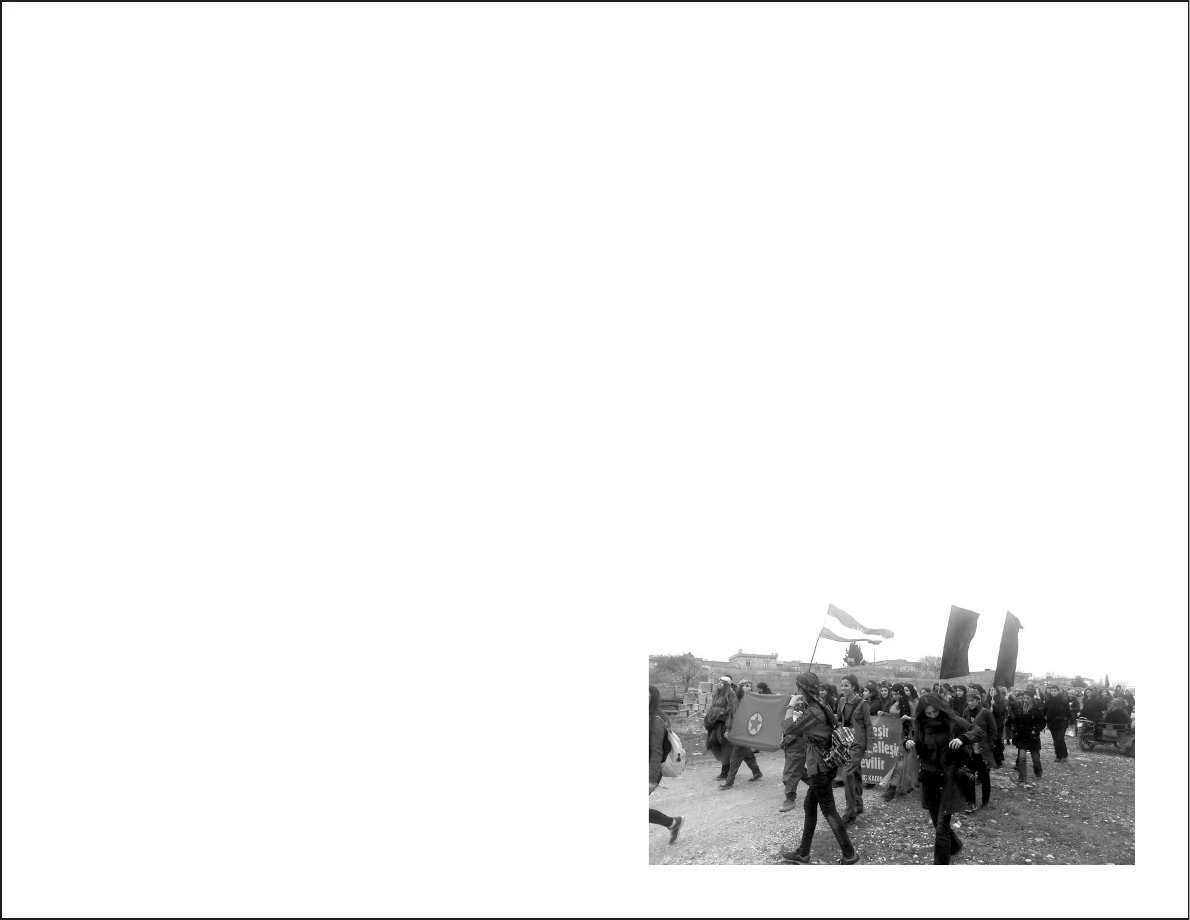
case, we call in the family and the husband for a discussion. We explain to him our attitude
toward violence and present him with the woman’s demands.
If people are to take our movement seriously, they have to take our demands seriously. That’s also
true when the woman prefers to separate, and she has to return the gifts she received at the
wedding and the dowry. During the period of the divorce, we stand with her.
3
A district council in Wan
How is your council organized?
About 15,000 people live in our urban district. We have street councils, district councils, and city
councils. When a street council cant solve a problem, it’s passed to the district council. If the
district council can’t solve it, nor the city council, it’s discussed in the DTK. Wan has thirty-one
districts, five of which have a council. Our work is highly collective and communal, and so we’re
always considering things in terms of the other districts.
Do you receive outside financial support?
That wouldn’t fit our ideology. We’re autonomous. So we don’t accept financial support…
What else does the district council do?
We have a committee where district people can bring their complaints, like domestic violence nd
quarrels between neighbors. Let’s say a family can’t afford to pay for a child’s school uniform, or
some parents don’t want to send their daughter to school. They come to us.
4
Amed City Council
What’s happening with the cooperatives?
We have cooperatives that grow vegetables and pickle them. Women cultivate mushrooms, or bake
bread, to achieve economic independence. Those are a few of the projects that we have under way.
There’s also the clay house project, which helps homeless people build clay houses. And comunes
already exist in many rural places, with the goal of providing for themselves.
What do legal committees do?
When we talk about judicial matters, you have to understand that we’re trying to organize a
society without a state. Many people who have legal disputes or other problems that need solving
don’t go to the Turkish courts anymore – they come to the city councils. So many of the city
councils are developing legal committees to handle legal issues, and people are learning to rely on
them to solve their problems.
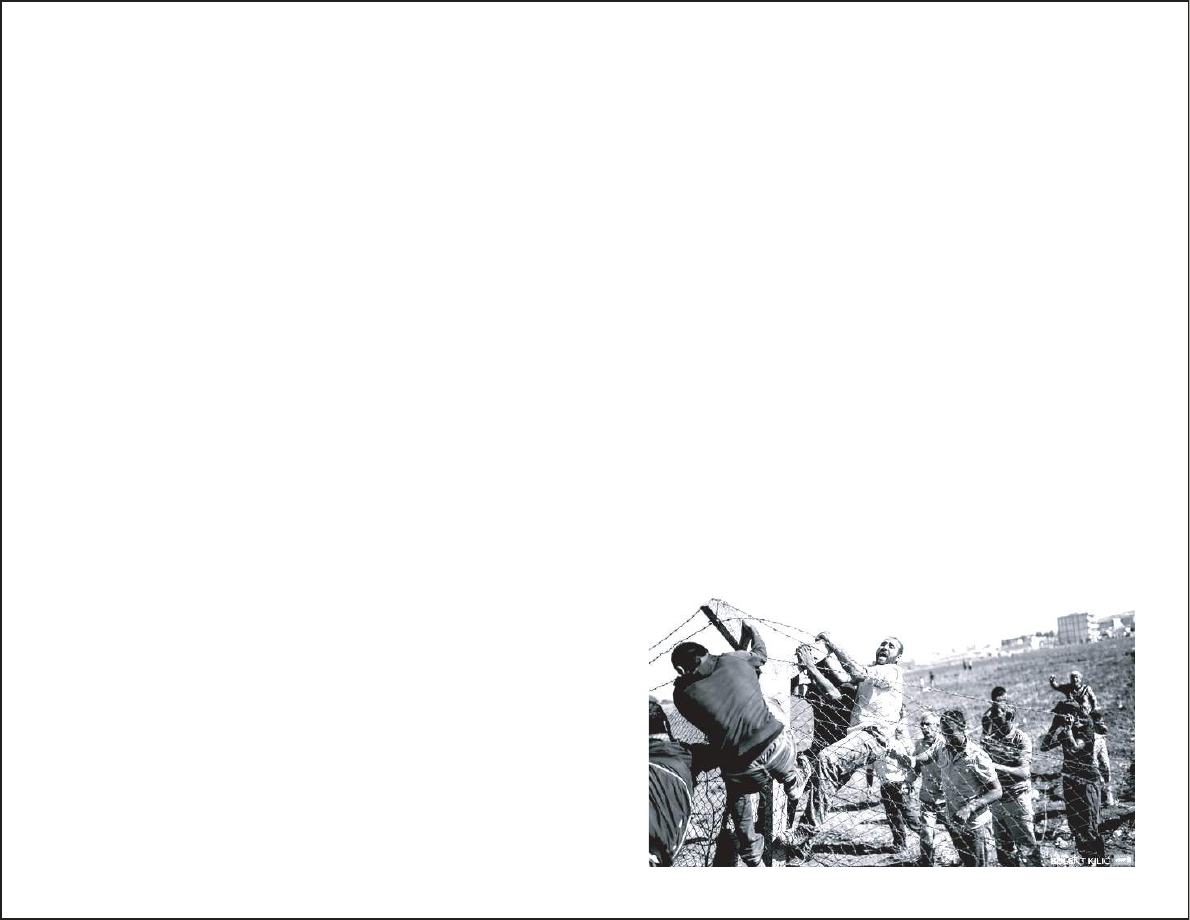
5
The Democratic Society Congress, DTK, was founded in 2005 as a democratic
confederation for the pro-Kurdish BDP and other political parties, civil society
organizations, religious communities, and women’s and youth organizations.
On July, 14, 2011, more than eight hundred participants from different
tendencies assembled in Amed and issued the Call for Democratic Autonomy, by a
common declaration. The published document called for democratic autonomy in
eight dimensions: politics, justice, self-defense, culture, society, economics, ecology,
and diplomacy. The state [Turkey] promptly criminalized the DTK, as the highest
institution of democratic autonomy, and initiated judicial proceedings against it.
As an example of the DTK’s work, one of our interviewees described the
arbitration of blood feuds. DTK members try yo end a blod feud before it can
escalate. But they avoid the state courts; instead they discuss and hopefully solve
the problem peacefully, within the community.
A member of the DTK explained his work:
A practical example: a man called me up and shouted, ‘My wife has left me-I’m gonna kill her!
Bring her back, or I’ll kill her!’ I tried to talk to talk him down over the phone, but when I
couldn’t, I went over to his place. We talked for a long time, but I couldn’t get him to see reason.
Now, I had been married for twenty-five years. I finally told this man. “ My wife also left me.
Should I kill her? Yesterday we had an argument. I hit her, and so she left me. Was she right, or
am I right?’ He thought about it, then hung his head and apologized. Now, don’t get me wrong -
that never really happened between me and my wife - I just told him it did.
I was mayor for a year, during which time I as a delegate to the DTK. I’ve seen many cases of
blood feuds and honor killings, for which the state has no solution. We stepped in and because we
better understand people’s sensitivities, we were able to solve the problem. I could tell you about
innumerable cases like that. Many of our mayors and delegates face such situations. They do these
individual interventions, but every locality also has a peace committee, from the BDP or the
DTK, that tries to mediate conflicts.
These excerpts are interviews from the book Democratic Autonomy in Northern
Kurdistan by TATORT Kurdistan, translated by Janet Biehl, and accounts from the
article Democratic Autonomy in Rojava also by TATORT.
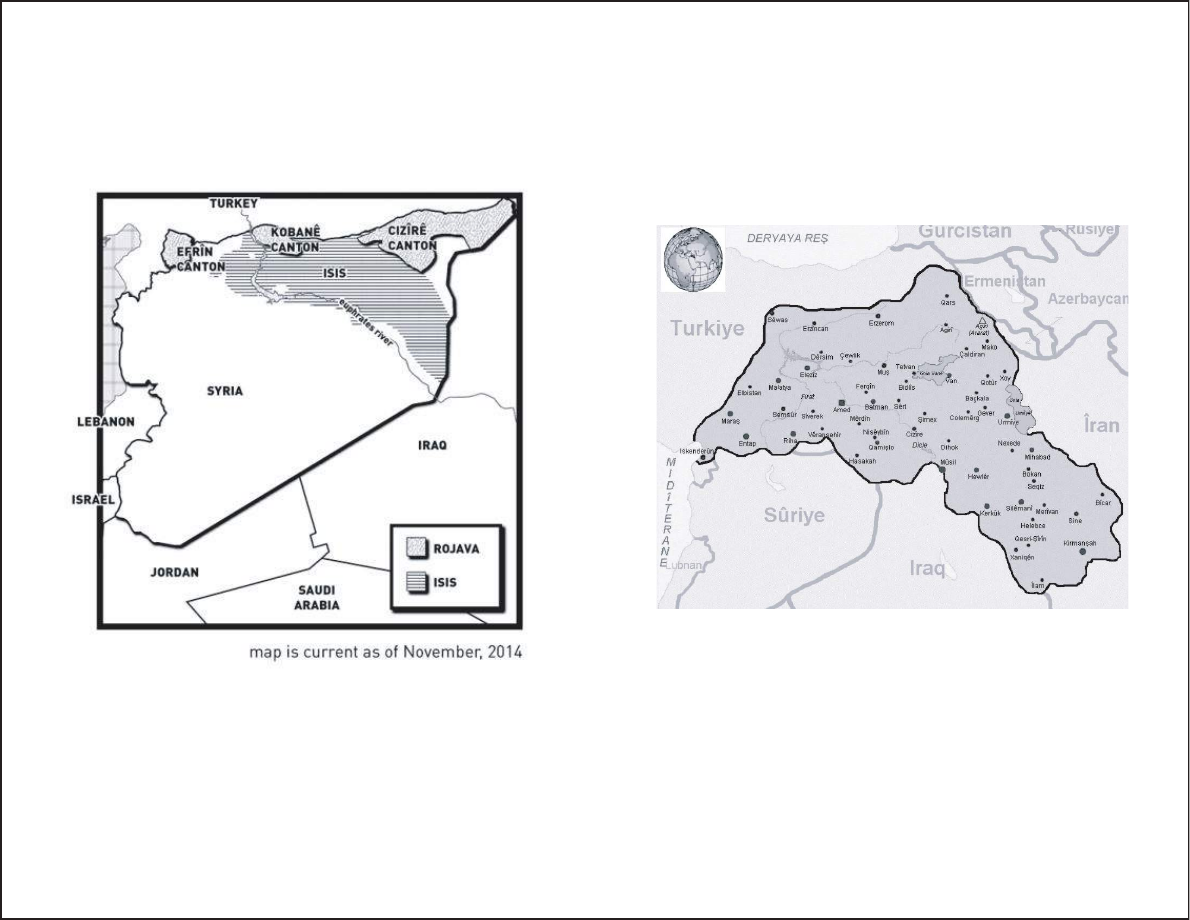
Cities in Kurdistan.

Rojava Solidarity NYC is an anarchist organization that aims to spread info and
show solidarity with the revolutionary region of Rojava.
rojavasolidaritynyc@gmail.com
Wyszukiwarka
Podobne podstrony:
Cyber Warriors in the Middle East Syrian E Army
Philosophy and Theology in the Middle Ages by GR Evans (1993)
Byrd, emergence of village life in the near east
Khenchen Thrangu Rinpoche Stages of Meditation in the Middle Way School
My Farewell To Israel The Thorn in the Mid East Jack Bernstein
The Nazi Party in the Fast East, 1931 45
Dees Marie Angel In The Middle
141 Środek, nie zawsze złoty Malcolm not in the middle, Jay Friedman, Jun 2, 2019
Jonathan Cook Israel and the Clash of Civilisations Iraq, Iran and the Plan to Remake the Middle E
Geertz, Clifford The Near East In The Far East On Islam In Indonesia
Who Lost the Middle East
Khenchen Thrangu Rinpoche Stages of Meditation in the Middle Way School
5 The fllet prison in the Middle Ages
use of the charge in the latin east 1192 1291
The Zionist Plan For The Middle East Prof Israel Shahak
I Marc Carlson Leatherworking in the Middle Ages
Byrd, emergence of village life in the near east
Gailhard The exchanges of copper in the Ancient Middle East
Standing Trial Law and the Person in the Modern Middle East
więcej podobnych podstron